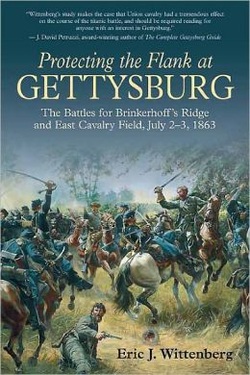
Eric J. Wittenberg
Savas Beatie – 2nd Printing 2013
ISBN: 978-1-61121-094-1
Image Courtesy of Barnes and Noble
Easily considered the least visited section of the battlefield, Eric J. Wittenberg handles this area with a great amount of scholarly information and gives a narrative which is action packed from beginning to end. Though initially published by Thomas Publications in 2002, the second edition published by Savas Beatie allowed Wittenberg to add more to his work including an appendix which disproves the ideas previously about General Stuart.
Eric J. Wittenberg has written many works on the Civil War including his other work on the cavalry during the Battle of Gettysburg, Gettysburg’s Forgotten Cavalry Action, and co-authored One Continuous Fight along with David J. Petruzzi and Michael Nugent. He has won the Bachelder-Coddington Literary Award in 1998 along with the Army Historical Foundation’s Distinguished Writing Award for Reprint, 2011.
Not only does Wittenberg handle the East Cavalry Field well, but he handles the Battle for Brinkerhoff’s Ridge which is also something not talked about as much in the annals of Gettysburg. For a battle which has more than a thousand books written about it, the East Cavalry Battlefield and Brinkerhoff’s Ridge never got their due until this book was released. Upon the release of this book in 2002 under Thomas Publications, it was the only book in print which detailed the East Cavalry Field and Brinkerhoff Ridge. Now there are imitators who use this work as the backbone of their study. What is most interesting about Wittenberg’s work is the ability in which he disproves the common theory of Stuart riding around the Union lines and piercing Cemetery Ridge from behind as Pickett, Pettigrew and Trimble would have hit it from the front. He states that nowhere in any of the official reports of Lee, Longstreet or Stuart does it mention that plan. It is beneficial for anyone interested to read the appendix in which he studies this more in depth than he does in the body of the work. Also, since the section of East Cavalry Battlefield is not traversed as much as the regular field, he offers an appendix which is a driving tour accompanied by pictures of some intricate monuments. The aspect of the book for which is most appreciated is the participation of General Custer, the youngest Union general at the time of the battle. History tends only to remember Custer at Little Big Horn and the disaster which happened there, but at Gettysburg, Custer shines as one of the greatest cavalry leaders in this engagement.
I cannot recommend enough this pivotal work on the Battle of Gettysburg. Though it had been released in its first edition in 2002, Wittenberg and Savas Beatie has released a work which has been expanded and is easily accessible for the readers more interested in this area of battle. The method in which he disproves the “planned” use of Stuart during the battle fills the holes in the study which never had many legs to stand on. Thankfully, he ended the debate about what had happened with Stuart on the day of the third and historians can now look differently at the tactics being used that day. Wittenberg has proven that there is always more to write about Gettysburg and that the subject never dulls even one hundred and fifty years after the event.
 RSS Feed
RSS Feed
